 September 29, the Confederate army moved north. Progress is rapid, and its vanguards reach Pocahontas, Tennessee, the same evening. Van Dorn, however, suffered a first setback when Northern cavalry patrols, after holding off their Confederate counterparts, burned the bridges over the Hatchie River, which the Southerners had to cross to continue their progress. When Confederate engineers begin repairing them the next day, after the Gray Horsemen have taken control of the eastern shore, the Union command realizes that Van Dorn's objective is probably Corinth .
September 29, the Confederate army moved north. Progress is rapid, and its vanguards reach Pocahontas, Tennessee, the same evening. Van Dorn, however, suffered a first setback when Northern cavalry patrols, after holding off their Confederate counterparts, burned the bridges over the Hatchie River, which the Southerners had to cross to continue their progress. When Confederate engineers begin repairing them the next day, after the Gray Horsemen have taken control of the eastern shore, the Union command realizes that Van Dorn's objective is probably Corinth .
The march on Corinth
On Grant's orders, Rosecrans assembled all his forces at Corinth, except for a brigade of McKean's division, commanded by John Oliver, which would act as an outpost at Chewalla. Grant also orders Ord to lend a hand to Rosecrans. When the Confederates were finally able to get back on the road on the morning of October 2, Oliver quickly feared that the enemy would cut him off from his rear. He evacuated the locality, so that Van Dorn and his men could bivouac the same evening in Chewalla, without having encountered any opposition. The assault on Corinth, a dozen kilometers away, will be for the next day .
Given its staffing problem, Rosecrans opted for a defense in depth . He deployed, in front of the former Confederate entrenchments, the Oliver Brigade – the latter having the mission of slowing down the enemy advance. Set back, slightly in front of the Halleck line, stands the rest of the division, the brigades of John McArthur and Marcellus Crocker. Davies' division is immediately to the right of this position, while Hamilton's, east of the Mobile &Ohio Railroad , is more advanced and practically at the height of the trenches of the outer line. As for Stanley's division, it was held in reserve south-west of Corinth. For his part, Van Dorn, who had only a vague idea of the northern dispositions, planned to launch Lovell in a direct attack along the Chewalla road. Hoping that this action will lead Rosecrans to strip his right, he will then launch the rest of his army against it, between the road to Memphis and the Mobile &Ohio .
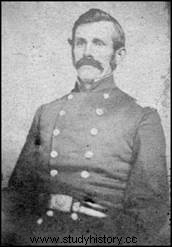 At dawn on October 3, Oliver's brigade exchanged fire with southern scouts, including the intensity increases from hour to hour. Quickly, the entire Lovell division attacks him. The pressure is too great, and Oliver's men, deployed as skirmishers, begin to retreat. Rosecrans asks his subordinate to hold out at all costs by relying on the outer line of defence, particularly on a hill which allows good placement of artillery – something rare in this very wooded area. With Oliver calling for reinforcements, Rosecrans advances McArthur's brigade. The latter reached the entrenchments around 9 a.m., and the serious things began followed by an attack by Lovell's forward elements. This one is cut short because of the murderous fire of the northern cannons, which almost immediately reject the attackers under the cover of the woods. However, with the appearance of Confederate reinforcements - Maury's Division - threatening to overwhelm his right wing, McArthur called for help, and obtained it with the entire Davies Division. Now present in force, Lovell and Maury launched a major attack, but the northern artillery continued to cause them considerable losses.
At dawn on October 3, Oliver's brigade exchanged fire with southern scouts, including the intensity increases from hour to hour. Quickly, the entire Lovell division attacks him. The pressure is too great, and Oliver's men, deployed as skirmishers, begin to retreat. Rosecrans asks his subordinate to hold out at all costs by relying on the outer line of defence, particularly on a hill which allows good placement of artillery – something rare in this very wooded area. With Oliver calling for reinforcements, Rosecrans advances McArthur's brigade. The latter reached the entrenchments around 9 a.m., and the serious things began followed by an attack by Lovell's forward elements. This one is cut short because of the murderous fire of the northern cannons, which almost immediately reject the attackers under the cover of the woods. However, with the appearance of Confederate reinforcements - Maury's Division - threatening to overwhelm his right wing, McArthur called for help, and obtained it with the entire Davies Division. Now present in force, Lovell and Maury launched a major attack, but the northern artillery continued to cause them considerable losses.
Things change when Albert Rust's brigade enters the scene, on the far right of the Confederate device. His soldiers from Alabama and Kentucky charged with bayonets, at a run, straight on the Federal position, finally forcing McArthur to fall back around 11 a.m. The intervention of Silas Baldwin's brigade, which Davies sent to help McArthur and whose leader was wounded in action, slowed down the southern advance for a time, but the law of numbers ended up speaking:Van Dorn weigh the bulk of his army against only a fraction of that of Rosecrans. The situation of the Northerners became all the more critical in that by retreating, McArthur left exposed the left of Davies, from whom he had, to make matters worse, borrowed four additional regiments without informing him. Its flank is therefore completely unprotected , and Maury's division hastened to attack it while that of Hébert came into play on its front. Davies' men put up a desperate resistance, but they soon lose their two other brigade commanders:Pleasant Hackleman receives a bullet in the neck from which he dies a few hours later, Richard Oglesby a projectile in the lungs which he will survive. Davies' division managed to avoid the rout despite everything, and tried to reestablish itself on the Halleck line, which McArthur tried to hold.
As 3 p.m. approaches, a strange wavering seems to reign in the northern army. Despite the intensity of the fighting and the difficulties encountered, the reserves remained at gunpoint. Rosecrans seems oddly passive. In reality, he is only beginning to realize that the current enemy thrust is his main attack, not a feigned one intended to draw his forces away from an enveloping action against his left flank, as he initially believed. Left alone with Crocker's brigade, McKean did not notice any suspicious troop movements in this sector of the battlefield - and for good reason, since he was facing only William H. Jackson's cavalry brigade, which acts as a flank-guard of the southern right. Free from his fears by this observation, Rosecrans ordered McKean to join the rest of his division, and redeployed that of Stanley on College Hill. The apparent inaction of Rosecrans, however, weighs on the morale of his troops, and the rumor spreads in the northern lines that he would have been killed... Informed of the rumor, the general immediately undertakes to deny it. He will spend the rest of the day tirelessly riding the most exposed places, shouting encouragement or insults at the stragglers – depending on the source – and nearly being shot down on several occasions.
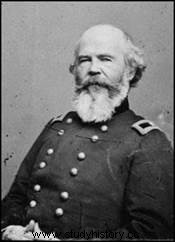 To the far right of the Federals, Charles Hamilton has no troops in front of him either – and for good reason, since almost all of the enemy army is concentrated west of the Mobile &Ohio railroad. . By repelling McArthur and Davies, Van Dorn ventured quite far behind Hamilton's back, but did not seem to care at all:as if magnetized by Corinth, the Confederates continued to attack straight ahead. Rosecrans decides to take advantage of the situation:instead of ordering Hamilton to retreat on the Halleck line, he makes him perform a conversion to the left, the purpose of the maneuver being then to attack the flank and the rear of the southern army . The Hamilton Division, however, was relatively isolated, and it took some time for the order to reach them. The appearance, unexpected but without follow-up, of Southern soldiers facing his position – perhaps Frank Armstrong’s horsemen – further delays his redeployment. The maneuver itself turned out to be complex:the two northern brigades – commanded by Napoleon Bonaparte Buford and Jeremiah Sullivan – had to cross thick thickets, then the railway embankment. Endless hours passed before the division was ready to attack.
To the far right of the Federals, Charles Hamilton has no troops in front of him either – and for good reason, since almost all of the enemy army is concentrated west of the Mobile &Ohio railroad. . By repelling McArthur and Davies, Van Dorn ventured quite far behind Hamilton's back, but did not seem to care at all:as if magnetized by Corinth, the Confederates continued to attack straight ahead. Rosecrans decides to take advantage of the situation:instead of ordering Hamilton to retreat on the Halleck line, he makes him perform a conversion to the left, the purpose of the maneuver being then to attack the flank and the rear of the southern army . The Hamilton Division, however, was relatively isolated, and it took some time for the order to reach them. The appearance, unexpected but without follow-up, of Southern soldiers facing his position – perhaps Frank Armstrong’s horsemen – further delays his redeployment. The maneuver itself turned out to be complex:the two northern brigades – commanded by Napoleon Bonaparte Buford and Jeremiah Sullivan – had to cross thick thickets, then the railway embankment. Endless hours passed before the division was ready to attack.
Meanwhile, the Confederates renew their assaults on the Halleck line. Again, the northern artillery played a decisive role in keeping the attackers at bay. Firing their ammunition faster than they received it, Davies' two batteries finally withdrew after an hour and a half, when their caissons were empty. Without their support, the northern infantry resist bravely despite everything. Although having received one hundred rounds per man in the morning, they had almost exhausted their ammunition around 5 p.m., but received some in extremis news. It was not until the southern brigade of John C. Moore, of Maury's division, managed to wedge itself into a wedge between Davies and McKean's divisions, that the Federals abandoned the position. Rosecrans then called in one of Stanley's brigades, that of Joseph Mower, to cover Davies' withdrawal. The Federals resisted for a while, around 6 p.m., around an isolated dwelling nicknamed “the White House”, but ended up falling back on the College Hill line. When Hamilton finally begins his flank attack, the sun has practically set, making his attempt futile . As darkness descends on Corinth, the Confederates are less than a mile from the railroad depot, and the Northerners are practically backed by the first houses in town.
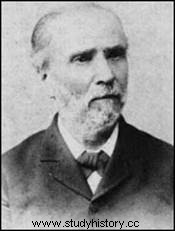 The Final Assault?
The Final Assault?
Convinced of being on the verge of winning, Van Dorn as well as Rosecrans will regret not having had an extra hour of daylight to develop their respective attacks. The southern general takes advantage of the darkness to redeploy his troops. His plan for the following day was the exact opposite of that which had been his on October 3:at Hébert, reinforced by the brigade of William Cabell – taken from the Maury division – to fix the northern forces by attacking on the left; the rest of the army will then attack, Maury in the center, Lovell on the right. Rosecrans, for his part, repositioned his divisions so that the most exposed points were held by the troops who had fought the least. Stanley's division thus held the center, between the Williams and Robinett batteries, which protected the railway depot. McKean was placed to his left and back; Davies held the immediate outskirts of the city, as far as the Powell battery, located north of Corinth. Finally, Hamilton will cover the right:Sullivan's brigade at Powell's battery, that of N.B. Buford in flank-guard and in rear, to ward off any attempt to outflank.
Van Dorn is convinced that he will succeed in breaking through the northern lines and "finish the job" by taking Corinth - an idea he had already had on the morning of the second day of the Battle of Pea Ridge. That of Corinth, in many respects, is manifestly a reissue. However, it neglects several crucial factors. The Federals, first of all, are in a situation where their lines are tightened, supported by solid fortifications, and their backs to the wall – they have no other alternative but to resist at all costs. His own men, moreover, suffered greatly. Throughout the American West, the summer of 1862 was particularly dry. It was this drought, by abnormally lowering the level of the Mississippi, which forced Farragut to lift his blockade of Vicksburg. The rains that soaked the roads at the time of the battle of Iuka were only a rainy episode without a future. What is nicknamed in Quebec “the summer of the Indians”, which is not a simple thaw before the fall but a real hot season, brief but intense, has now hit the region. The heat is overwhelming . Even in a humid and semi-swampy region like that of Corinth, many streams are dry. Exhausted from marches and battles, overwhelmed by the heat in their woolen uniforms, the southern soldiers also suffered from thirst. By the morning of October 4, many of them were unable to join the ranks, and the Confederate army was weakened accordingly.
At 4 a.m., three Confederate batteries, which Van Dorn had massed against the northern left, opened fire. Their mission is to engage in a mock preliminary bombardment, one more precaution to disorient Rosecrans before the attack of the Hébert division – which is, itself, a diversion. Hébert must advance as soon as there is enough light, but as the sun begins to rise, the left wing of the Southerners remains silent . The false bombardment turns into a regular artillery duel which will last for three hours, seriously undermining the southern guns – which cannot, unlike their opponents, benefit from the cover of the redoubts. Taken aback by the inaction of his subordinate, Van Dorn sends three aides-de-camp in search of Hébert, but he is nowhere to be found. It is finally at 7 o'clock that the Cajun presents himself at Van Dorn's headquarters... but it is to be called in sick. Martin Green, who has never exercised divisional command, replaces him at short notice. By the time he takes charge of his new command, it is past 8 o'clock. His four brigades are advancing in a disorderly fashion and Cabell's has even fallen behind.
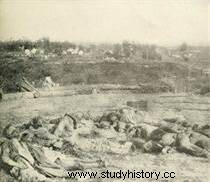 At the same time, losing patience – he had to attack a bit after the action started on his left – Dabney Maury marches his two brigades on the northern center, C.W. Phifer on the left, John C. Moore on the right. It was then approximately 8:20 a.m. The two units took turns attacking the Robinett Battery . Attacking first, Moore's men were confronted with the heavy 30-pound projectiles of the Parrott siege guns installed in the battery, then a murderous salvo from the northern infantry which stopped them dead. Taking over, Phifer's men attempted to circumvent the Federal position from the right, taking advantage of the cover provided by a small ravine. This time, the Confederates come into contact, but the defenders refuse to yield and a hand-to-hand fight ensues. Relatively rare in such a situation, it is the attackers who have the bottom:the Phifer brigade must retreat.
At the same time, losing patience – he had to attack a bit after the action started on his left – Dabney Maury marches his two brigades on the northern center, C.W. Phifer on the left, John C. Moore on the right. It was then approximately 8:20 a.m. The two units took turns attacking the Robinett Battery . Attacking first, Moore's men were confronted with the heavy 30-pound projectiles of the Parrott siege guns installed in the battery, then a murderous salvo from the northern infantry which stopped them dead. Taking over, Phifer's men attempted to circumvent the Federal position from the right, taking advantage of the cover provided by a small ravine. This time, the Confederates come into contact, but the defenders refuse to yield and a hand-to-hand fight ensues. Relatively rare in such a situation, it is the attackers who have the bottom:the Phifer brigade must retreat.
Maury then decides to attempt a third assault, again calling on Moore's brigade. This time, the maneuver is more elaborate:while the brigade will pretend to bypass the Robinett battery on the left, one of its regiments will separate from it unexpectedly to charge it directly. Colonel William Rogers, a former comrade in arms of Jefferson Davis in Mexico, volunteered to carry out this action at the head of the 2 th Texas Legion. The helping hand fails to succeed. Rogers was shot as he planted his unit's flag on the parapet of Robinett's Battery. His men managed to overwhelm the defenders. One of Stanley's brigade commanders, Joseph Mower, was wounded in the neck and, in the turmoil, he was captured. Moments later, one of his regiments, the 11 th Missouri, reverses the stock price. His colonel judiciously had him lengthened and kept in reserve; when the Union soldiers stood up and opened fire, the effect of surprise was enough to break the Confederate momentum. The 11 th Missouri counterattacks and takes back the battery Robinett, throwing Maury's division back for good, shortly after 11 o'clock. As for Mower, the Northerners will recover him later in the day, in a field hospital evacuated by their enemies.
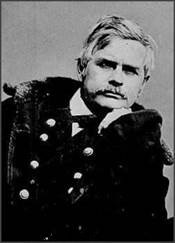 On the right wing of the Northerners, the Hébert division, despite its late attack, is progressing. A disorderly but massive charge shakes the federal line . The Powell battery was attacked in front by the brigade of Elijah Gates, while that of John Martin enfiladed Sullivan's two forward regiments which covered its right, and whose flank had been left unwisely exposed. On the wings, Green's brigade assaulted the rest of Davies' division, while Bruce Colbert's brigade attempted to surround the entire Union force. The northern soldiers are caught cold by this massive charge, which the grapeshot vomited by their guns does not seem able to stop. Powell's Battery was taken, its guns turned against their former owners, and most of Davies' division fell apart. The Confederate advance, however, ended up being a victim of its own success:the disorganized masses of Southern infantry spilled into the streets of Corinth, where they were greeted with grapeshot by other cannons that Rosecrans had hastily deployed. We are fighting very close to his headquarters. Finally, the arrival of elements taken from the Mower Brigade allows the trend to be reversed and Corinth to be reconquered, street by street.
On the right wing of the Northerners, the Hébert division, despite its late attack, is progressing. A disorderly but massive charge shakes the federal line . The Powell battery was attacked in front by the brigade of Elijah Gates, while that of John Martin enfiladed Sullivan's two forward regiments which covered its right, and whose flank had been left unwisely exposed. On the wings, Green's brigade assaulted the rest of Davies' division, while Bruce Colbert's brigade attempted to surround the entire Union force. The northern soldiers are caught cold by this massive charge, which the grapeshot vomited by their guns does not seem able to stop. Powell's Battery was taken, its guns turned against their former owners, and most of Davies' division fell apart. The Confederate advance, however, ended up being a victim of its own success:the disorganized masses of Southern infantry spilled into the streets of Corinth, where they were greeted with grapeshot by other cannons that Rosecrans had hastily deployed. We are fighting very close to his headquarters. Finally, the arrival of elements taken from the Mower Brigade allows the trend to be reversed and Corinth to be reconquered, street by street.
Lawsuits and regrets
Further north, Hamilton's division also received orders from Rosecrans to restore the situation. N.B. Buford goes to meet the Colbert brigade and blocks its progress, preventing it from flanking the northern army. As for the second line of Sullivan's brigade, it managed to rally part of Davies' division behind a ridge, stopped the Confederates, then counter-attacked. Slowly the Southerners were pushed back, despite the late intervention of Cabell's Brigade, until Sullivan retook Battery Powell. His soldiers having practically no more ammunition, Van Dorn finally decides to make them retreat. Above all, he understood that insisting further would be futile:his chance to seize Corinth has passed . Shortly after ordering Lovell's division, which had remained inactive until then, to probe the northern left, he changed his mind and sent it to the other side of the battlefield to cover the retreat of Hébert's division - then, soon, of the whole army. Although a rearguard fight between skirmishers will continue for much of the day, by noon the Battle of Corinth is essentially over.
Despite its small scale, the clash was deadly. The Northerners had about 2,500 dead and wounded, their adversaries having lost more than 4,200 men. The number of killed exceeds 800. Van Dorn's situation is then critical. His men are exhausted and at the mercy of a vigorous pursuit. The northern skirmishers who mark the retreating Confederate army pick up many stragglers who, thirsty, can no longer follow. There will be, despite this, no prosecution . In the afternoon, Rosecrans received reinforcements in the form of a brigade, come by forced march from Jackson and commanded by one of Grant's proteges and trusted men, James Birdseye McPherson. However, these soldiers are tired, like the rest of the northern army, and Rosecrans decides to let his troops rest until the next morning. A decision that Grant will deeply regret, and which will further fuel the controversy between the two generals. In Rosecrans' defense, it should be noted that he could hardly count on his cavalry, since he dispersed it widely to cover his left flank when he still believed it was threatened.
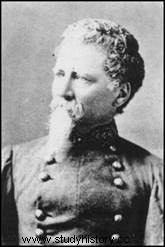 Earl Van Dorn's army is not yet saved, however. On the morning of October 5, while his leading elements were recrossing the Hatchie southeast of Pocahontas, they were intercepted by the division of Stephen Hurlbut. The Northerners line up in battle order in front of the village of Metamora, one kilometer from the bridge which spans the Hatchie at the height of the Davis farm – hence the name of the battle of the Davis bridge generally given to the engagement. It was the Moore brigade, already well beaten the day before while trying to storm the Robinett battery, which suffered the brunt of the shock of two federal brigades, soon reinforced by a third. Flanked, the southern unit must abandon the western bank of the Hatchie and take refuge behind the Davis bridge, where the rest of the Maury division joins it. Edward Ord having appeared in person on the battlefield, he takes charge of operations and pushes Hurlbut's division forward. The Federals succeeded in forcing the passage of the bridge, then in driving back their enemies to the top of the hill which overhangs the bridge. Ord was wounded in the ankle, but his men managed to seize the eminence at the end of the afternoon, despite the intervention of the Cabell brigade, relatively spared from the fighting the day before. With Hurlbut's division in possession of the bridge, and Rosecrans' army in pursuit and dangerously approaching Chewalla, Van Dorn appears to be crushed between a rock and a hard place.
Earl Van Dorn's army is not yet saved, however. On the morning of October 5, while his leading elements were recrossing the Hatchie southeast of Pocahontas, they were intercepted by the division of Stephen Hurlbut. The Northerners line up in battle order in front of the village of Metamora, one kilometer from the bridge which spans the Hatchie at the height of the Davis farm – hence the name of the battle of the Davis bridge generally given to the engagement. It was the Moore brigade, already well beaten the day before while trying to storm the Robinett battery, which suffered the brunt of the shock of two federal brigades, soon reinforced by a third. Flanked, the southern unit must abandon the western bank of the Hatchie and take refuge behind the Davis bridge, where the rest of the Maury division joins it. Edward Ord having appeared in person on the battlefield, he takes charge of operations and pushes Hurlbut's division forward. The Federals succeeded in forcing the passage of the bridge, then in driving back their enemies to the top of the hill which overhangs the bridge. Ord was wounded in the ankle, but his men managed to seize the eminence at the end of the afternoon, despite the intervention of the Cabell brigade, relatively spared from the fighting the day before. With Hurlbut's division in possession of the bridge, and Rosecrans' army in pursuit and dangerously approaching Chewalla, Van Dorn appears to be crushed between a rock and a hard place.
By resisting all day, Dabney Maury's soldiers managed to save the Confederate army's precious supply and ammunition wagons. During the night, Van Dorn's scouts manage to find, without too much difficulty thanks to the drought, another crossing point on the Hatchie. Effectively covered by Lovell's division, the Southern army crossed the river without incident before falling back on Ripley, then Holly Springs. Once again, William Rosecrans let his prey escape. Once again, Earl Van Dorn has led his army to the brink of annihilation following a reckless plan. The two men, however, were to experience different fates. While Rosecrans would continue his ascent, Van Dorn would foot the bill. The Battle of Corinth had ended in failure for the Confederacy, a costly failure at that, and ultimately had little bearing on the outcome of operations in Kentucky. Appalled by the heavy casualties - almost a fifth of the forces engaged - Southern public opinion demanded Van Dorn's head. From October 10, he was subordinated to a new command entrusted to General John Pemberton, then court-martialed. He would, however, be acquitted, but would never regain command of an army.
Sources
- General article on the Battle of Corinth.
- Civil War Preservation Trust page dedicated to the Battle of Corinth.
- Robert C. SUHR, Battle of Corinth, America’s Civil War, May 1999 [online].
- Account of the Battle of Corinth in the northern magazine Harper's Weekly of the 1 st November 1862.
- Tennessee in the Civil War article on the Battle of Davis Bridge.
- Civil War Preservation Trust page on the Battle of Davis Bridge
